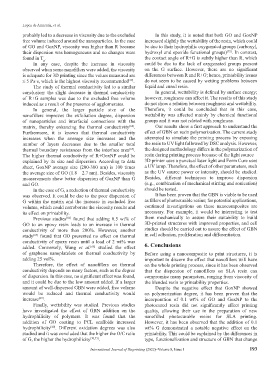Page 207 - IJB-8-1
P. 207
Lopez de Armentia, et al.
probably led to a decrease in viscosity due to the excluded In this study, it is noted that both GO and GoxNP
free volume induced around the nanoparticles. In the case increased slightly the wettability of the resin, which could
of GO and GoxNP, viscosity was higher than R because be due to their hydrophilic oxygenated groups (carboxyl,
their dispersion was homogeneous and no changes were hydroxyl and epoxide functional groups) . In contrast,
[72]
found in T . the contact angle of R+G is subtly higher than R, which
g
In any case, despite the increase in viscosity could be due to the lack of oxygenated groups present
observed when some nanofillers were added, the viscosity on the G surface. However, there are no significant
is adequate for 3D printing since the values measured are differences between R and R+G; hence, printability issues
≤ 5 Pa·s, which is the highest viscosity recommended . do not seem to be caused by wetting problems between
[39]
The study of thermal conductivity led to a similar liquid and cured resin.
conclusion: the slight decrease in thermal conductivity In general, wettability is defined by surface energy;
of R+G samples was due to the excluded free volume however, roughness can affect it. The results of this study
induced as a result of the presence of agglomerates. do not show a relation between roughness and wettability.
In general, the larger particle size of the Therefore, it could be concluded that in this case,
nanofillers improves the exfoliation degree, dispersion wettability was affected mainly by chemical functional
of nanoparticles and interfacial connections with the groups and it was not related with roughness.
matrix, thereby enhancing the thermal conductivity . Our results show a first approach to understand the
[64]
Furthermore, it is known that thermal conductivity effect of GBN on resin polymerization. The current study
increases when the average size increases and the attempted to simulate the printing process by exposing
number of layers decreases due to the smaller total the resin to UV light followed by DSC analysis. However,
thermal boundary resistances from the interface area . the designed methodology differs in the polymerization of
[65]
The higher thermal conductivity of R+GoxNP could be resin during printing process because of the light source –
explained by its size and dispersion. According to data 3D printer uses a punctual laser light and Form Cure uses
sheet, GoxNP average size (200-300 nm) is 100 times a UV lamp. Therefore, the effect of other parameters, such
the average size of GO (1.8 – 2.7 nm). Besides, viscosity as the UV source power or intensity, should be studied.
measurements show better dispersion of GoxNP than G Besides, different techniques to improve dispersion
and GO. (e.g., combination of mechanical stirring and sonication)
In the case of G, a reduction of thermal conductivity should be tested.
was observed. It could be due to the poor dispersion of It has been proven that the GBN is viable to be used
G within the matrix and the increase in excluded free as fillers of photocurable resins; for potential applications,
volume, which could corroborate the viscosity results and continued investigations on these nanocomposites are
its effect on printability. necessary. For example, it would be interesting to test
Previous studies found that adding 0.5 wt% of them mechanically to assure their suitability to build
[66]
GO to an epoxy resin leads to an increase in thermal 3D-printed structures with improved properties, and cell
conductivity of more than 200%. However, another studies should be carried out to assure the effect of GBN
study found that GO presented no effect on thermal in cell adhesion, proliferation and differentiation.
[67]
conductivity of epoxy resin until a load of 2 wt% was 6. Conclusions
added. Conversely, Wang et al. studied the effect
[68]
of graphene nanoplatelets on thermal conductivity by Before using a nanocomposite to print structures, it is
adding 25 vol%. important to discern the effect that nanofillers will have
Therefore, the effect of nanofillers on thermal on the whole printing process, since it has been observed
conductivity depends on many factors, such as the degree that the dispersion of nanofillers on SLA resin can
of dispersion. In this case, no significant effect was found, compromise many parameters, ranging from viscosity of
and it could be due to the low amount added. If a larger the blended resin to printability properties.
amount of well-dispersed GBN were added, free volume Despite the negative effect that GoxNP showed
would be reduced and thermal conductivity would on polymerization degree, it has been proven that the
increase . incorporation of 0.1 wt% of GO and GoxNP to the
[69]
Finally, wettability was studied. Previous studies photocured resin did not significantly affect printing
have investigated the effect of GBN addition on the quality, allowing their use in the preparation of new
hydrophilicity of polymers. It was found that the nanofilled photocurable resins for SLA printing.
addition of GO coating to PCL scaffolds increased However, it has been observed that the addition of 0.1
hydrophilicity . Different oxidation degrees was also wt% G demonstrated a notable negative effect on the
[40]
studied and it was concluded that the higher the O/C ratio printability. This could be explained by the differences in
of G, the higher the hydrophilicity [70,71] . type, functionalization and structure of GBN that change
International Journal of Bioprinting (2022)–Volume 8, Issue 1 193

